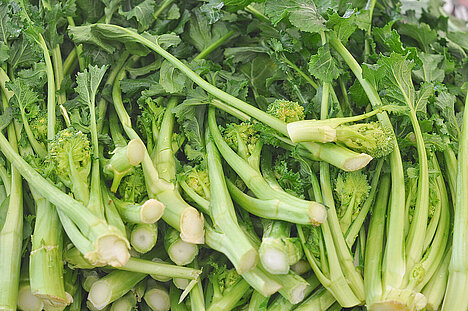Turnip stalk

What is turnip stalk?
Turnip stalk is a spring vegetable that is usually obtained from the young stalked leaves of the turnip (Brassica rapa ssp. rapa). However, there are also other varieties, such as the "Namenia" variety bred from the wild turnip (Brassica rapa ssp. silvestris) or the independent variety with strongly pinnate leaves (Brassica rapa var. rapifera subvar. pabularia), which form no or only a small turnip.
Turnip rape belongs to the cruciferous family, as do radish, mustard, cress and cabbage. This plant family is characterized by a special group of secondary plant substances: glucosinolates, also known as mustard oil glycosides. These substances give turnip tops their typical cabbage smell and slight pungency.
What are the benefits of turnip tops for dogs?
Turnip greens are a highly nutritious vegetable that offers many health benefits for dogs. Here are some of them:
- Turnip greens are rich in potassium, a mineral that regulates blood pressure and supports the cardiovascular system.
- Turnip greens are high in vitamin K, a vitamin that is involved in blood clotting and strengthens bones.
- Turnip tops are easy to digest and soothe the stomach thanks to their essential oils.
- Turnip tops provide plenty of vitamin C, a vitamin that strengthens the immune system and protects against infections.
- Turnip tops are a good source of vitamin A and beta-carotene, two antioxidants that protect cells from free radicals and improve eyesight.
- Turnip tops have a high content of calcium, a mineral that also strengthens bones and teeth.
- Turnip tops are low in calories but high in fiber, which aids digestion and increases the feeling of satiety.
- Turnip tops have a slight antibacterial effect due to their mustard oil glycosides, which can ward off harmful germs.
What are the disadvantages of turnip tops for dogs?
Turnip greens are a very healthy vegetable for dogs, but there are some disadvantages or risks to be aware of. Here are some of them:
- Turnip greens can cause bloating or diarrhea in sensitive dogs, especially when fed raw or in large quantities.
- Turnip tops can be counterproductive in dogs with thyroid problems, as they are a goitrogenic food that can inhibit the absorption of iodine.
- Turnip tops can lead to congestion in dogs with kidney problems, as they contain a lot of potassium, which the kidneys have to excrete.
- Turnip stalk can lead to an increased tendency to bleed in dogs with blood clotting disorders or who are taking blood-thinning medication, as it contains a lot of vitamin K, which promotes blood clotting.
How can you prepare turnip tops for dogs?
Turnip greens are a vegetable that can be prepared in various ways for dogs. Here are some tips and ideas:
- Turnip tops should be thoroughly washed and the roots removed before feeding.
- Turnip tops should be cut or chopped into small pieces to make them easier to digest.
- Turnip tops are best steamed or boiled to reduce the pungency and increase digestibility.
- Turnip tops can be served as a side dish with meat or fish, or as an ingredient in homemade dog food.
- Turnip stalk can also be used as a treat by drying it or processing it into potato chips.
- Turnip stalk should only be fed in moderation, about one to two tablespoons per day for a medium-sized dog.
Turnip tops are a vegetable that offers many health benefits for dogs, but also has some disadvantages or risks. It should therefore only be fed in moderation and after consultation with your vet. Turnip greens are a tasty and nutritious vegetable that can be prepared in various forms for dogs.
If you notice any signs of hypersensitivity or poisoning in your dog, you should see your vet immediately. We are not a substitute for a vet, but we try to be as accurate as possible. Every dog reacts differently and we recommend you get a second opinion or consult your vet if in doubt.
Stay healthy and take good care of your four-legged friend!😊